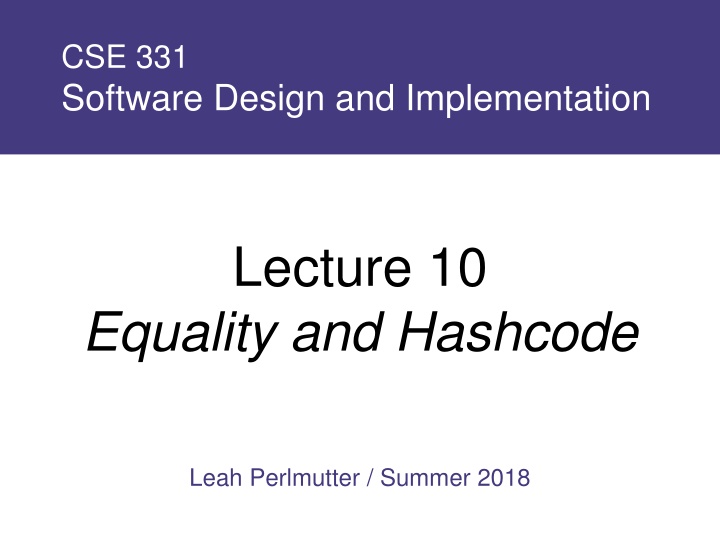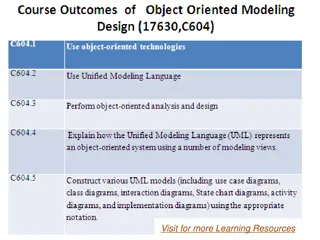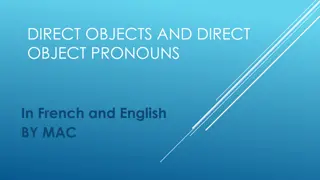Equality and Hashcode in Object Comparison
Mathematical properties and implementation challenges of object equality in software design, exploring the concepts of reference equality, concrete vs abstract values, and efficient implementation strategies for determining object equality.
Download Presentation

Please find below an Image/Link to download the presentation.
The content on the website is provided AS IS for your information and personal use only. It may not be sold, licensed, or shared on other websites without obtaining consent from the author.If you encounter any issues during the download, it is possible that the publisher has removed the file from their server.
You are allowed to download the files provided on this website for personal or commercial use, subject to the condition that they are used lawfully. All files are the property of their respective owners.
The content on the website is provided AS IS for your information and personal use only. It may not be sold, licensed, or shared on other websites without obtaining consent from the author.
E N D
Presentation Transcript
CSE 331 Software Design and Implementation Lecture 10 Equality and Hashcode Leah Perlmutter / Summer 2018
Announcements This coming week is the craziest part of the quarter! Quiz 4 due tomorrow 10 pm HW4 due tomorrow 10 pm HW5 due next Thursday Hardest hw in 331 and future hws build on it Section tomorrow! important things you need to know for HW5 Midterm review session Friday 3:30-5 in this room Midterm Monday 1:10-2:10 in this room Mid-quarter course evaluation Friday (during part of class) Visitor: Jamal from the Center for Teaching and Learning
Object equality A simple idea?? Two objects are equal if they have the same value A subtle idea: intuition can be misleading Same object or same contents? Same concrete value or same abstract value? Same right now or same forever? Same for instances of this class or also for subclasses? When are two collections equal? How related to equality of elements? Order of elements? What if a collection contains itself? How can we implement equality efficiently?
Mathematical properties of equality Reflexive An object equals itself a.equals(a) == true Two-way implication (if and only if) a.equals(b) b.equals(a) Symmetric Order doesn t matter a.equals(b) b.equals(c) a.equals(c) Transitive transferable In mathematics, a relation that is reflexive, transitive, and symmetric is an equivalence relation
Reference equality Reference equality means an object is equal only to itself a == b only if a and b refer to (point to) the same object Reference equality is an equivalence relation Reflexive a==a Symmetric a==b b==a Transitive a==b b==c a==c Reference equality is the smallest equivalence relation on objects Hardest to show two objects are equal (must be same object) Cannot be any more restrictive without violating reflexivity Sometimes but not always what we want
What might we want? Date d1 = new Date(12,27,2013); Date d2 = new Date(12,27,2013); Date d3 = d2; // d1==d2 ? // d2==d3 ? // d1.equals(d2) ? // d2.equals(d3) ? d1 d2 d3 12 month 27 day 2013 year 12 month 27 day 2013 year Sometimes want equivalence relation bigger than == Java takes OOP approach of letting classes overrideequals
Overriding Object s equals
Object.equals method public class Object { public boolean equals(Object o) { return this == o; } } Implements reference equality Subclasses can override to implement a different equality But library includes a contractequals should satisfy Reference equality satisfies it So should any overriding implementation Balances flexibility in notion-implemented and what-clients- can-assume even in presence of overriding
equals specification public boolean equals(Object obj) Indicates whether some other object is equal to this one. The equals method implements an equivalence relation: It is reflexive: for any reference value x, x.equals(x) should return true. It is symmetric: for any reference values x and y, x.equals(y) should return true if and only if y.equals(x) returns true. It is transitive: for any reference values x, y, and z, if x.equals(y) returns true and y.equals(z) returns true, then x.equals(z) should return true. It is consistent: for any reference values x and y, multiple invocations of x.equals(y) consistently return true or consistently return false, provided no information used in equals comparisons on the object is modified. For any non-null reference value x, x.equals(null) should return false.
equals specification Equals contract is: Weak enough to allow different useful overrides Strong enough so clients can assume equal-ish things Example: To implement a set Complete enough for real software So: Equivalence relation Consistency, but allow for mutation to change the answer Asymmetric with null null.equals(a) raises exception for non-null a, a.equals(null) must return false
An example A class where we may want equals to mean equal contents public class Duration { private final int min; // RI: min>=0 private final int sec; // RI: 0<=sec<60 public Duration(int min, int sec) { assert min>=0 && sec>=0 && sec<60; this.min = min; this.sec = sec; } } Should be able to implement what we want and satisfy the equalscontract
How about this? public class Duration { public boolean equals(Duration d) { return this.min==d.min && this.sec==d.sec; } } Two bugs: 1. Violates contract for null (not that interesting) Can add if(d==null) return false; But our fix for the other bug will make this unnecessary 2. Does not override Object s equals method (more interesting)
Overloading: String.indexOf int indexOf(int ch) Returns the index within this string of the first occurrence of the specified character. int indexOf(int ch, int fromIndex) Returns the index within this string of the first occurrence of the specified character, starting the search at the specified index. int indexOf(String str) Returns the index within this string of the first occurrence of the specified substring. int indexOf(String str, int fromIndex) Returns the index within this string of the first occurrence of the specified substring, starting at the specified index.
Overriding: String.equals In Object: public boolean equals(Object obj) ... The equals method for class Object implements the most discriminating possible equivalence relation on objects; that is, for any non-null reference values x and y, this method returns true if and only if x and y refer to the same object (x == y has the value true) ... In String: public boolean equals(Object anObject) Compares this string to the specified object. The result is true if and only if the argument is not null and is a String object that represents the same sequence of characters as this object.
Overriding vs. Overloading Consider the following classes Object Foo Bar class Foo extends Object { Shoe m(Shoe x, Shoe y){ ... } } class Bar extends Foo {...} Footwear Shoe HighHeeledShoe
Overriding vs. Overloading Footwear Shoe HighHeeledShoe Foo Bar The result is method overriding The result is method overloading The result is a type-error None of the above Method in Foo Shoe m(Shoe x, Shoe y){ ... } Possible Methods in Bar Shoe m(Shoe q, Shoe z) { ... } HighHeeledShoe m(Shoe x, Shoe y) { ... } Shoe m(FootWear x, HighHeeledShoe y) { ... } Shoe m(FootWear x, FootWear y) { ... } Shoe m(HighHeeledShoe x, HighHeeledShoe y) { ... } Shoe m(Shoe y) { ... } FootWear m(Shoe x, Shoe y) { ... } Shoe z(Shoe x, Shoe y) { ... } overriding overriding overloading overloading overloading overloading type error new method
Overloading versus overriding In Java: A class can have multiple methods with the same name and different parameters (number or type) A method overrides a superclass method only if it has the same name and exact same argument types So Duration s boolean equals(Duration d) does not override Object s boolean equals(Object d) Overloading is sometimes useful to make several closely related functions with the same name Overloading is sometimes confusing since the rules for what- method-gets-called are complicated [Overriding covered in CSE143, but not overloading]
Overload resolution Java s language spec for resolving Method Invocations (including overload resolution) is about 18 pages long. In summary The declared types of parameters and the object it s called on determine the signature of the method to call declared type is also known as compile-time type The runtime type of the object it s called on determines which implementation of that method signagure gets called this is called dynamic dispatch
Example: Overloading overloading...oops! public class Duration { public boolean equals(Duration d) { } } Duration d1 = new Duration(10,5); Duration d2 = new Duration(10,5); Object o1 = d1; Object o2 = d2; d1.equals(d2); o1.equals(o2); d1.equals(o2); o1.equals(d2); d1.equals(o1); // true [using Object s equals] // true // false(!) // false(!) // false(!)
Overload resolution In summary The declared types of parameters and the object it s called on determine the signature of the method to call The runtime type of the object it s called on determines which implementation of that method signagure gets called o1.equals(d2) o1 has declared type Object so the signature equals(Object) is chosen The runtime type of o1 is Duration, so Duration s equals(Object) method gets called. Since Duration doesn t implement equals(Object), the superclass Object s implementation is called.
Overload resolution In summary The declared types of parameters and the object it s called on determine the signature of the method to call The runtime type of the object it s called on determines which implementation of that method signagure gets called o1.equals(o2) o2 has declared type Object so the signature equals(Object) is chosen The runtime type of o1 is Duration, so Duration s equals(Object) method is chosen. Since Durationdoesn t implement equals(Object), the superclass Object s implementation is called.
Example fixed (mostly) public class Duration { public boolean equals(Object d) { } } Duration d1 = new Duration(10,5); Duration d2 = new Duration(10,5); Object o1 = d1; Object o2 = d2; d1.equals(d2); o1.equals(o2); d1.equals(o2); o1.equals(d2); d1.equals(o1); // true [overriding] // true // true [overriding] // true [overriding] // true [overriding]
But wait! This doesn t actually compile: public class Duration { public boolean equals(Object o) { return this.min==o.min && this.sec==o.sec; } }
Really fixed now public class Duration { public boolean equals(Object o) { if(! o instanceof Duration) return false; Duration d = (Duration) o; return this.min==d.min && this.sec==d.sec; } } Cast statement Cast cannot fail We want equals to work on any pair of objects Gets null case right too (null instanceof C always false) So: rare use of cast that is correct and idiomatic This is what you should do (cf. Effective Java)
Satisfies the contract public class Duration { public boolean equals(Object o) { if(! o instanceof Duration) return false; Duration d = (Duration) o; return this.min==d.min && this.sec==d.sec; } } Reflexive: Yes Symmetric: Yes, even if o is not a Duration! (Assuming o s equals method satisfies the contract) Transitive: Yes, similar reasoning to symmetric
Even better Great style: use the @Override annotation when overriding public class Duration { @Override public boolean equals(Object o) { } } Compiler warning if not actually an override Catches bug where argument is Duration or String or ... Alerts reader to overriding Concise, relevant, checked documentation
Summary: Overriding Equals Equals contract Equals must implement an equivalence relation Reflexive a.equals(a) Symmetric a.equals(b) b.equals(a) Transitive a.equals(b) b.equals(c) a.equals(c) Equals must override, not overload Object s equals Must take in a parameter of type Object After checking instanceof, can cast argument to the right class
Equals and Subclassing
Okay, so are we done? Done: Understanding the equals contract Implementing equals correctly for Duration Overriding Satisfying the contract [for all types of arguments] Alas, matters can get worse for subclasses of Duration No perfect solution, so understand the trade-offs
Two subclasses class CountedDuration extends Duration { public static numCountedDurations = 0; public CountedDuration(int min, int sec) { super(min,sec); ++numCountedDurations; } } class NanoDuration extends Duration { private final int nano; public NanoDuration(int min, int sec, int nano){ super(min,sec); this.nano = nano; } public boolean equals(Object o) { } }
CountedDuration is good CountedDuration does not override equals Will (implicitly) treat any CountedDuration like a Duration when checking equals Any combination of Duration and CountedDuration objects can be compared Equal if same contents in min and sec fields Works because o instanceof Duration is true when o is an instance of CountedDuration
Now NanoDuration [not so good!] If we don t override equals in NanoDuration, then objects with different nano fields will be equal So using everything we have learned: @Override public boolean equals(Object o) { if (! (o instanceof NanoDuration)) return false; NanoDuration nd = (NanoDuration) o; return super.equals(nd) && nano == nd.nano; } But we have violated the equals contract Hint: Compare a Duration and a NanoDuration
The symmetry bug public boolean equals(Object o) { if (! (o instanceof NanoDuration)) return false; NanoDuration nd = (NanoDuration) o; return super.equals(nd) && nano == nd.nano; } This is not symmetric! Duration d1 = new NanoDuration(5, 10, 15); Duration d2 = new Duration(5, 10); d1.equals(d2); // false // true d2.equals(d1);
Fixing symmetry This version restores symmetry by using Duration s equals if the argument is a Duration (and not a NanoDuration) public boolean equals(Object o) { if (! (o instanceof Duration)) return false; // if o is a normal Duration, compare without nano if (! (o instanceof NanoDuration)) return super.equals(o); NanoDuration nd = (NanoDuration) o; return super.equals(nd) && nano == nd.nano; } Alas, this still violates the equals contract Transitivity: a.equals(b) b.equals(c) a.equals(c)
The transitivity bug Duration d1 = new NanoDuration(1, 2, 3); Duration d2 = new Duration(1, 2); Duration d3 = new NanoDuration(1, 2, 4); d1.equals(d2); d2.equals(d3); d1.equals(d3); // false! // true // true NanoDuration Duration NanoDuration 1 2 3 1 2 min min min 1 2 4 sec sec sec nano nano
No great solution Effective Java says not to (re)override equals like this Unless superclass is non-instantiable (e.g., abstract) Don t do it a non-solution given the equality we want for NanoDuration objects Two far-from-perfect approaches on next two slides: 1. Don t make NanoDuration a subclass of Duration 2. Change Duration s equals such that only Duration objects that are not (proper) subclasses of Duration are equal
Not quite sufficient: the getClass trick Different run-time class checking to satisfy the equals contract: @Override public boolean equals(Object o) { // in Duration if (o == null) return false; if (! o.getClass().equals(getClass())) return false; Duration d = (Duration) o; return d.min == min && d.sec == sec; } But now Duration objects never equal CountedDuration objects Subclasses do not act like instances of superclass because behavior of equals changes with subclasses Generally considered wrong to break subtyping like this
Composition Choose composition over subclassing Often good advice: many programmers overuse (abuse) subclassing [see future lecture on proper subtyping] public class NanoDuration { private final Duration duration; private final int nano; } NanoDuration and Duration now unrelated No presumption they can be compared to one another Solves some problems, introduces others Can t use NanoDurations where Durations are expected (not a subtype) No inheritance, so need explicit forwarding methods
Slight alternative Can avoid some method redefinition by having Duration and NanoDuration both extend a common abstract class Or implement the same interface Leave overriding equals to the two subclasses Keeps NanoDuration and Durationfrom being used like each other But requires advance planning or willingness to change Duration when you discover the need for NanoDuration
Class hierarchy AbstractDuration Duration NanoDuration CountedDuration
Summary: Equals and Subclassing Be careful when creating subclasses equals needs to work! NanoDuration is not a proper Java subclass of Duration since we can t get equals to work More on the nuances of subclassing later! Unresolvable tension between What we want for equality What we want for subtyping This is one of the limitations of Java
Announcements This coming week is the craziest part of the quarter! Quiz 4 due tomorrow 10 pm HW4 due tomorrow 10 pm HW5 due next Thursday Hardest hw in 331 and future hws build on it Section tomorrow! important things you need to know for HW5 Midterm review session Friday 3:30-5 in this room Midterm Monday 1:10-2:10 in this room Mid-quarter course evaluation Friday (during part of class) Visitor: Jamal from the Center for Teaching and Learning
CSE 331 Software Design and Implementation Lecture 10 Equality and Hashcode (Continued) Leah Perlmutter / Summer 2018
Announcements Midterm review session Friday 3:30-5 in GUG 218 Midterm Monday 1:10-2:10 in GUG 218 Short lecture today Mid-quarter course evaluation (during part of class) Visitor: Jamal from the Center for Teaching and Learning
Equals and Collections
Sets and Equals A set is a collection that stores at most one copy of each item HashSet, TreeSet A map is a collection that stores keys and values, with at most one copy of each key TreeMap, HashMap, ... What does it mean to store at most one copy? public interface Set<E> A collection that contains no duplicate elements. More formally, sets contain no pair of elements e1 and e2 such that e1.equals(e2), and at most one null element.






















